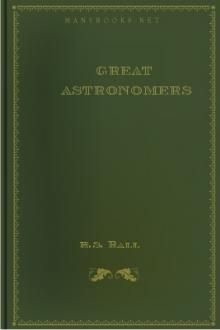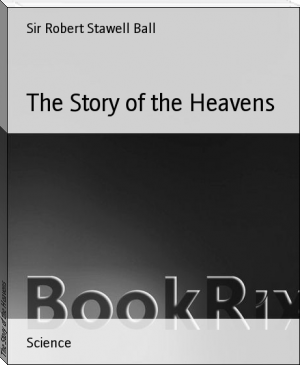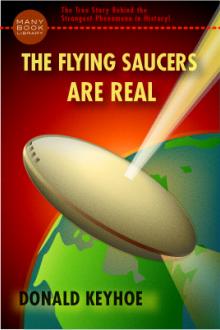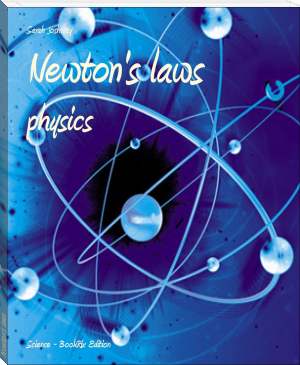Great Astronomers by Robert Stawell Ball (uplifting novels .txt) 📕

- Author: Robert Stawell Ball
- Performer: -
Book online «Great Astronomers by Robert Stawell Ball (uplifting novels .txt) 📕». Author Robert Stawell Ball
beautiful home at Collingwood, in Kent.
His health having gradually failed, he died on the 11th May,
1871, in the seventy-ninth year of his age.
THE EARL OF ROSSE.
The subject of our present sketch occupies quite a distinct
position in scientific history. Unlike many others who have risen
by their scientific discoveries from obscurity to fame, the great
Earl of Rosse was himself born in the purple. His father, who,
under the title of Sir Lawrence Parsons, had occupied a
distinguished position in the Irish Parliament, succeeded on the
death of his father to the Earldom which had been recently
created. The subject of our present memoir was, therefore, the
third of the Earls of Rosse, and he was born in York on June
17, 1800. Prior to his father’s death in 1841, he was known as
Lord Oxmantown.
The University education of the illustrious astronomer was begun
in Dublin and completed at Oxford. We do not hear in his case of
any very remarkable University career. Lord Rosse was, however, a
diligent student, and obtained a first-class in mathematics. He
always took a great deal of interest in social questions, and was
a profound student of political economy. He had a seat in the
House of Commons, as member for King’s County, from 1821 to
1834, his ancestral estate being situated in this part of
Ireland.
[PLATE: THE EARL OF ROSSE.]
Lord Rosse was endowed by nature with a special taste for
mechanical pursuits. Not only had he the qualifications of a
scientific engineer, but he had the manual dexterity which
qualified him personally to carry out many practical arts. Lord
Rosse was, in fact, a skilful mechanic, an experienced founder,
and an ingenious optician. His acquaintances were largely among
those who were interested in mechanical pursuits, and it was his
delight to visit the works or engineering establishments where
refined processes in the arts were being carried on. It has often
been stated—and as I have been told by members of his family,
truly stated—that on one occasion, after he had been shown over
some large works in the north of England, the proprietor bluntly
said that he was greatly in want of a foreman, and would indeed be
pleased if his visitor, who had evinced such extraordinary
capacity for mechanical operations, would accept the post. Lord
Rosse produced his card, and gently explained that he was not
exactly the right man, but he appreciated the compliment, and this
led to a pleasant dinner, and was the basis of a long friendship.
I remember on one occasion hearing Lord Rosse explain how it was
that he came to devote his attention to astronomy. It appears
that when he found himself in the possession of leisure and of
means, he deliberately cast around to think how that means and
that leisure could be most usefully employed. Nor was it
surprising that he should search for a direction which would offer
special scope for his mechanical tastes. He came to the
conclusion that the building of great telescopes was an art which
had received no substantial advance since the great days of
William Herschel. He saw that to construct mighty instruments for
studying the heavens required at once the command of time and the
command of wealth, while he also felt that this was a subject the
inherent difficulties of which would tax to the uttermost whatever
mechanical skill he might possess. Thus it was he decided that
the construction of great telescopes should become the business of
his life.
[PLATE: BIRR CASTLE.
PLATE: THE MALL, PARSONSTOWN.]
In the centre of Ireland, seventy miles from Dublin, on the border
between King’s County and Tipperary, is a little town whereof we
must be cautious before writing the name. The inhabitants of that
town frequently insist that its name is Birr,* while the official
designation is Parsonstown, and to this day for every six people
who apply one name to the town, there will be half a dozen who use
the other. But whichever it may be, Birr or Parsonstown—and I
shall generally call it by the latter name—it is a favourable
specimen of an Irish county town. The widest street is called the
Oxmantown Mall. It is bordered by the dwelling-houses of the
chief residents, and adorned with rows of stately trees. At one
end of this distinctly good feature in the town is the Parish
Church, while at the opposite end are the gates leading into Birr
Castle, the ancestral home of the house of Parsons. Passing
through the gates the visitor enters a spacious demesne,
possessing much beauty of wood and water, one of the most pleasing
features being the junction of the two rivers, which unite at a
spot ornamented by beautiful timber. At various points
illustrations of the engineering skill of the great Earl will be
observed. The beauty of the park has been greatly enhanced by the
construction of an ample lake, designed with the consummate art by
which art is concealed. Even in mid-summer it is enlivened by
troops of wild ducks preening themselves in that confidence which
they enjoy in those happy localities where the sound of a gun is
seldom heard. The water is led into the lake by a tube which
passes under one of the two rivers just mentioned, while the
overflow from the lake turns a water-wheel, which works a pair of
elevators ingeniously constructed for draining the lowlying parts
of the estate.
*Considering the fame acquired by Parsonstown from Lord Rosse’s
mirrors, it may be interesting to note the following extract from
“The Natural History of Ireland,” by Dr. Gerard Boate, Thomas
Molyneux M.D., F.R.S., and others, which shows that 150 years ago
Parsonstown was famous for its glass:—
“We shall conclude this chapter with the glass, there having been
several glasshouses set up by the English in Ireland, none in
Dublin or other cities, but all of them in the country; amongst
which the principal was that of Birre, a market town, otherwise
called Parsonstown, after one Sir Lawrence Parsons, who, having
purchased that lordship, built a goodly house upon it; his son
William Parsons having succeeded him in the possession of it;
which town is situate in Queen’s County, about fifty miles
(Irish) to the southwest of Dublin, upon the borders of the two
provinces of Leinster and Munster; from this place Dublin was
furnished with all sorts of window and drinking glasses, and such
other as commonly are in use. One part of the materials, viz.,
the sand, they had out of England; the other, to wit the ashes,
they made in the place of ash-tree, and used no other. The
chiefest difficulty was to get the clay for the pots to melt the
materials in; this they had out of the north.”—Chap. XXI., Sect.
VIII. “Of the Glass made in Ireland.”
Birr Castle itself is a noble mansion with reminiscences from the
time of Cromwell. It is surrounded by a moat and a drawbridge of
modern construction, and from its windows beautiful views can be
had over the varied features of the park. But while the visitors
to Parsonstown will look with great interest on this residence of
an Irish landlord, whose delight it was to dwell in his own
country, and among his own people, yet the feature which they have
specially come to observe is not to be found in the castle itself.
On an extensive lawn, sweeping down from the moat towards the
lake, stand two noble masonry walls. They are turreted and clad
with ivy, and considerably loftier than any ordinary house. As
the visitor approaches, he will see between those walls what may
at first sight appear to him to be the funnel of a steamer lying
down horizontally. On closer approach he will find that it is an
immense wooden tube, sixty feet long, and upwards of six feet in
diameter. It is in fact large enough to admit of a tall man
entering into it and walking erect right through from one end to
the other. This is indeed the most gigantic instrument which has
ever been constructed for the purpose of exploring the heavens.
Closely adjoining the walls between which the great tube swings,
is a little building called “The Observatory.” In this the
smaller instruments are contained, and there are kept the books
which are necessary for reference. The observatory also offers
shelter to the observers, and provides the bright fire and the cup
of warm tea, which are so acceptable in the occasional intervals
of a night’s observation passed on the top of the walls with no
canopy but the winter sky.
Almost the first point which would strike the visitor to Lord
Rosse’s telescope is that the instrument at which he is looking is
not only enormously greater than anything of the kind that he has
ever seen before, but also that it is something of a totally
different nature. In an ordinary telescope he is accustomed to
find a tube with lenses of glass at either end, while the large
telescopes that we see in our observatories are also in general
constructed on the same principle. At one end there is the
object-glass, and at the other end the eye-piece, and of course it
is obvious that with an instrument of this construction it is to
the lower end of the tube that the eye of the observer must be
placed when the telescope is pointed to the skies. But in Lord
Rosse’s telescope you would look in vain for these glasses, and it
is not at the lower end of the instrument that you are to take
your station when you are going to make your observations. The
astronomer at Parsonstown has rather to avail himself of the
ingenious system of staircases and galleries, by which he
is enabled to obtain access to the mouth of the great tube. The
colossal telescope which swings between the great walls, like
Herschel’s great telescope already mentioned, is a reflector, the
original invention of which is due of course to Newton. The
optical work which is accomplished by the lenses in the ordinary
telescope is effected in the type of instrument constructed by
Lord Rosse by a reflecting mirror which is placed at the lower end
of the vast tube. The mirror in this instrument is made
of a metal consisting of two parts of copper to one of tin. As we
have already seen, this mixture forms an alloy of a very peculiar
nature. The copper and the tin both surrender their distinctive
qualities, and unite to form a material of a very different
physical character. The copper is tough and brown, the tin is no
doubt silvery in hue, but soft and almost fibrous in texture.
When the two metals are mixed together in the proportions I have
stated, the alloy obtained is intensely hard and quite brittle
being in both these respects utterly unlike either of the two
ingredients of which it is composed. It does, however, resemble
the tin in its whiteness, but it acquires a lustre far brighter
than tin; in fact, this alloy hardly falls short of silver itself
in its brilliance when polished.
[PLATE: LORD ROSSE’S TELESCOPE.
From a photograph by W. Lawrence, Upper Sackville Street, Dublin.]
The first duty that Lord Rosse had to undertake was the
construction of this tremendous mirror, six feet across, and about
four or five inches thick. The dimensions were far in excess of
those which had been contemplated in any previous attempt of the
same kind. Herschel had no doubt fashioned one mirror of four
feet in diameter, and many others of smaller dimensions, but the
processes which he employed had never been fully published, and it
was obvious that, with a large increase in dimensions,
great additional difficulties had to





Comments (0)